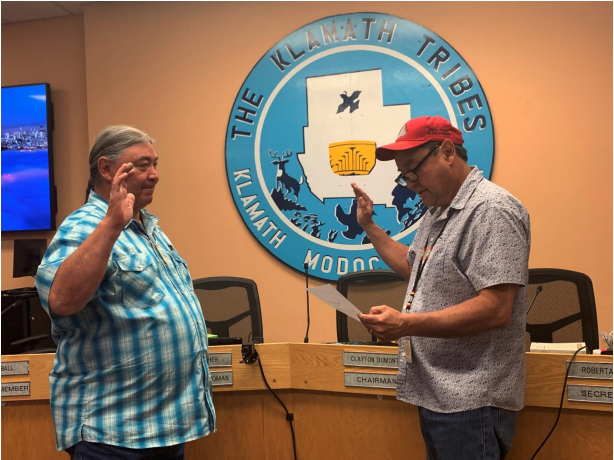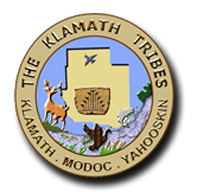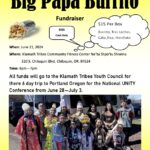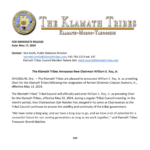FOR IMMEDIATE RELEASE Date: May 18, 2023
Contact: Clayton Dumont, Klamath Tribal Chairman cdumont.council@klamathtribes.com
Ken Smith, Public Relations Director kenneth.smith@klamathtribes.com; 541-783-2219 ext. 147
CHILOQUIN, Ore. — A new Klamath Tribal Council Member was sworn in yesterday. Perry Chocktoot will be replacing Adrian Witcraft, who resigned May 10. Chocktoot will hold the at-large seat for the remaining two years of a three-year term. Chocktoot is an elder with a wealth of experience. He was previously a member of the Council for two terms; a member of the Tribal Culture and Heritage Department for 18 years; a former Chairman of the Inter-Tribal Water Commission; a member of the Oregon Geographic Names Board; and currently serves as a member on the Oregon Energy Facility Siting Council.
Chocktoot said he comes from a mainstream tribal family, and during his tenure, he would like to see the elders, youth, and tribal members, in general, taken care of.
“Who we take our marching orders from is the General Council of this tribe,” he said. “That’s got to be a hood ornament for us, and we’ve got to take care of our people, in every way. Not just one way — housing, wood, every way. We need to make sure our people are healthy. We deserve the right.”
Chocktoot recognizes that this is a special time for the tribes, with many projects and issues being addressed. “Funding has allowed us to do a lot of things,” he said. “We just need to make sure they get done.”
He considers himself to be a traditional practitioner and is passionate about the land and environment. He is a master craftsman, skilled at making customary items like drums, canoes, arrowheads, bows, and arrows, and tans his own hides.
“I learned it from my father, and my father was a master,” Chocktoot said, “So, I’m carrying it on. I’m carrying it for our people. I even teach non-tribal people where to dig. We work on a seasonal round of gathering. Right now, we’re in the middle of fishing. We should be fishing. And at the end of May to June, we’re digging. We eat roots, and we’ll dig roots for a while. And then later on in the fall, it’s berries, and then hunting deer. I do a lot of it at all times of the year, but in the winter, that’s when the school goes for our kids. The stories, the histories, the legends. That needs to be taught to our children. We need to go back, in some regards, to the old way. And the old way is kindness and helpfulness for everybody. Some of us still do that, and some of us need to learn to do that.”
He said there is a new renaissance going on for all Tribal Nations as people return to their tribes and learn about their people, and being together with one another – being one.
“I think it’s a beautiful time to be alive right now,” he said, “and we need to welcome everybody, and that’s what I think we’re doing. At some point, we need a little more structure, a little more guidance, a little more knowledge, and I believe that’s what I bring. I bring a lot of historical knowledge.”
He admits that at his age, 60, time is no longer an asset. “The time when you’re old, it seems like you never have enough of it.”
He pointed to a map on the wall that had a blue line outlining the peak to peak boundary of the tribal land ceded to the United States in 1864 — more than 23 million acres — entering the tribes into the reservation era. When asked if he thought they could regain all of the ceded land, he responded, “Let’s give it a try.”
Chocktoot said getting back their land is a priority of his. He added that part of the reason for losing all of their land was that the tribes that fought the U.S. government during the Indian Wars lost their land, and those that assisted the government, kept their land. For this reason, he said, land acquisition is very important.
“When the government recognized us as a tribe in 1986 again,” Chocktoot said, “they did so without a land grant. They didn’t give us land. They said it was because they bought our land from us, that we sold our land. Hopefully now, through one way or another, we’ll get it all back.”
The largest stand of Ponderosa Pine was discovered on Klamath Tribes’ land, he said, and that was a valuable natural resource the U.S. Government wanted.
“They knocked down the largest stand of Ponderosa Pine on the planet,” Chocktoot said. “So now we have global warming and climate problems. And guess what? Those big giant trees fended off the weather, and it also kept weather here. Well, that’s what’s going on now. This past winter was a really good winter. Every year should be like that. Trees are a circle of life for us. What we breathe out, they breathe in…When you kill trees 500 and a thousand years old, you will never see that tree grow again, no matter what anybody says. They just have too much age on them, and we are just a blink in time.”
Perry Chocktoot takes the oath as he is sworn-in by Klamath Tribes Chairman Clayton Dumont. (Photo by Ken Smith/Klamath Tribes. Image is available for media use.)
About The Klamath Tribes
The Klamath Tribes primary mission is to “protect, preserve and enhance the spiritual, cultural and physical values and resources of the Klamath, Modoc and Yahooskin Peoples by maintaining the customs of our ancestors.” The heart of Tribal life is centered in the area of Chiloquin, Oregon and includes 12 Departments, Health Clinic, Childcare Center, Tribal Court, goos oLgi gowa Center, Research Station, and three tribal enterprises. The Klamath Tribes’ 12 departments facilitate service delivery to multiple aspects of tribal life, including health and fitness, education, economic development, social services, cultural preservation, natural resource protection and more. For more information visit https://klamathtribes.org/.
XXX





